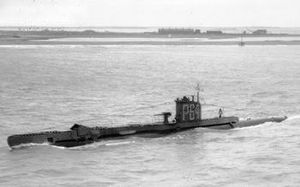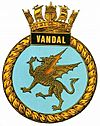HMS Vandal facts for kids

HMS Vandal
|
|
Quick facts for kids History |
|
|---|---|
| Ordered | 15 July 1941 |
| Builder | Vickers Armstrong, Barrow-in-Furness |
| Laid down | 17 March 1942 |
| Launched | 23 November 1942 |
| Commissioned | 20 February 1943 |
| Fate | Sunk in an accident on 24 February 1943 |
| Badge | |
| General characteristics | |
| Class and type | U-class submarine |
| Displacement |
|
| Length | 58.22 m (191 ft 0 in) |
| Beam | 4.90 m (16 ft 1 in) |
| Draught | 4.62 m (15 ft 2 in) |
| Propulsion |
|
| Speed |
|
| Complement | 27-31 |
| Armament |
|
HMS Vandal (P64) was a Royal Navy U-class submarine built by Vickers-Armstrong at Barrow-in-Furness, yard number 838. The submarine had the shortest career of any Royal Navy submarine, being lost with all 37 onboard just four days after commissioning.
Loss
The submarine, under the command of Lieutenant James S. Bridger, was lost whilst carrying out a three-day-long working up exercise following commissioning. The submarine was last seen leaving her anchorage on 24 February 1943 at Lochranza, in the North of the Isle of Arran before her rediscovery in December 1994. She had only just joined the Third Submarine Flotilla in Holy Loch, a major submarine base during the Second World War used extensively for trials and exercises.
There were initially conflicting reports over the possible position of the lost submarine, one submarine reported seeing a smoke candle two and a half miles (5 km) north of Inchmarnock, and another reported hearing hull tapping in a similar area. However a spotter plane reported a large oil slick about 2 miles (4 km) north of Arran (15 kilometres from Inchmarnock). An inquiry at the time of her loss ignored the report from the spotter plane and concluded that the submarine had sunk during the deep dive she was scheduled to perform on that day, somewhere north of Inchmarnock.
At the time Prime Minister Winston Churchill demanded a full report on the loss of the Vandal and asked if the submarine had been recovered. The reply from Flag Officer Submarines repeated the mistaken assumption that the Vandal lay in deep waters off Inchmarnock, where salvage would be impossible.
In 1994 the Scottish Branch of the Submariners Association finally persuaded the Navy to search the area north of Arran where a number of trawlers had reported their nets being snagged by an underwater object. A Royal Navy expedition aboard HMS Hurworth finally located the wreck in June 1994, 300 feet (100 m) below the surface 1.5 miles (3 km) northwest of Loch Ranza, roughly where the spotter plane had first reported the presence of an oil slick. The wreck lies in pitch darkness on a muddy slope 100 metres down with a 35 degree list to port. Her 12-pounder forward gun remains covered with a trawler's net, and the brass letters VANDAL are clearly visible.
There was only one survivor of Vandal's crew, Larry Gaines. At the time Gaines was too ill with earache to sail with the ship, and was replaced by a younger, less experienced crew member. For 60 years Gaines had blamed himself for the loss, as he believed his replacement had not secured the aft engine room hatch, one of Gaines' final checks before diving. Subsequent dives on the wreck revealed that the aft engine room hatch was closed, and this could not have been the cause of the sinking. Prior to this investigation, it was generally considered that human error in leaving a hatch open as the submarine dived had caused the loss. It was later proved that the submarine was on the surface and not diving when the accident occurred.
The ship was originally named HMS Unbridled. Before taking command of what was to be his first and last boat, skipper James Bridger assembled his crew on the jetty at Barrow, to inform them that she would henceforth be officially known as Vandal. This went against a long-held maritime tradition that to change the name of a ship risks bringing bad luck upon it and the crew.
Subsequent investigations
A team of divers investigated Vandal in August 2003, looking for an explanation for her mysterious sinking. They found a large section (about 4 ft) of the stern was missing and the aft engine room escape hatch was closed, but the forward escape hatch was open. In addition, the mooring lines were neatly stowed around both amidships and stern bollards, and the forward hydroplanes were in their stowed position. It is therefore likely that Vandal was on the surface when the incident occurred. The area that Vandal lies in is known as area "Quebec", and was used by submarines performing log calibrations over a "measured mile." So it is possible that log calibration work was being carried out, and although there are other explanations, this might suggest why she only travelled two miles (4 km) in one-and-a-half hours. Maintenance of the log on a submarine can be very hazardous as raising it for inspection can potentially breach the pressure hull and cause a serious flood. In the case of HMS Untamed (which sank three months after Vandal) incorrect procedure whilst carrying out log maintenance was the main contributing factor to the boat and her entire crew being lost. Had the hull been breached, whilst the forward escape hatch was open, the inrush of water could have overwhelmed the submarine. The starboard propeller blades were found to be worn down at their tips, indicating that either the propellers were turning (perhaps full astern) as Vandal hit the seabed, or whilst she was on the seabed in an attempt to drive her off the bottom.
This would imply there were survivors in the forward compartments of the submarine, and a report by the Lochranza pier master of seeing smoke candles on the surface gives further weight to this theory. Those not killed in the initial flooding in the aft compartments might have therefore attempted to use the forward escape hatch to leave the submarine and tried to make it to the surface, an endeavour that ultimately ended in failure. The submarine was not reported overdue until the following morning, and search vessels were finally deployed to the area twenty three hours later. It was during this time that a spotter plane observed a small concentrated patch of oil over what is now known to be Vandal's position. Three hours later this patch had drifted away and dispersed. All other hatches and external openings to the sea were discovered to be closed, and there were no external signs of hull damage, or collision.
Tributes
A memorial to those lost aboard HMS Vandal was erected beside the Caledonian MacBrayne ferry terminal at Lochranza Pier, Isle of Arran, by HM Submarines Old Comrades Association in 1997.
The wreck was one of those designated under the Protection of Military Remains Act 1986, which prohibits interference with the site by divers.


